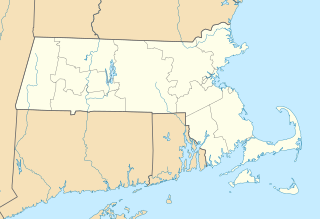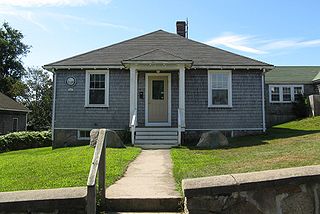
The Bombing of Tokyo was a series of firebombing air raids by the United States Army Air Forces during the Pacific campaigns of World War II. Operation Meetinghouse, which was conducted on the night of 9–10 March 1945, is regarded as the single most destructive bombing raid in human history. 16 square miles (41 km2) of central Tokyo were destroyed, leaving an estimated 100,000 civilians dead and over 1 million homeless.
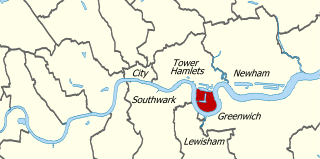
The Isle of Dogs is a district in East London and is in the London Borough of Tower Hamlets, and is a part of the East End. It is referred to as the Island, It is bounded on three sides by one of the largest meanders in the River Thames. The northern boundary has never been clearly or consistently defined but many accept it to be the (former) line of the West India South Dock. The name Isle of Dogs had no official status until 1987, with the creation of the Isle of Dogs Neighbourhood by Tower Hamlets London Borough Council.
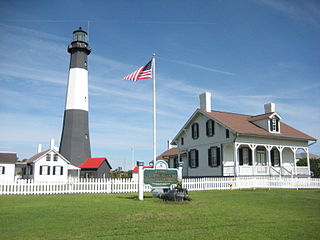
Tybee Island is a city and a barrier island located in Chatham County, Georgia, 18 miles (29 km) east of Savannah, United States. Though the name "Tybee Island" is used for both the island and the city, geographically they are not identical: only part of the island's territory lies within the city.

Treasure Island is an artificial island in the San Francisco Bay and a neighborhood in the city and county of San Francisco. Built 1936–37 for the 1939 Golden Gate International Exposition, the island's World’s Fair site is a California Historical Landmark. Buildings there have been listed on the National Register of Historic Places, and the historical Naval Station Treasure Island an auxiliary air facility are designated in the Geographic Names Information System.
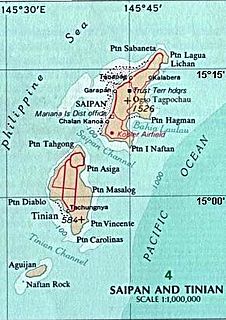
Tinian is one of the three principal islands of the Commonwealth of the Northern Mariana Islands. Together with uninhabited neighboring Aguigan, it forms Tinian Municipality, one of the four constituent municipalities of the Northern Marianas. Tinian's largest village is San Jose.

Operation Downfall was the proposed Allied plan for the invasion of Japan near the end of World War II. The planned operation was cancelled when Japan surrendered following the atomic bombings of Hiroshima and Nagasaki, the Soviet declaration of war, and the Soviet invasion of Manchuria. The operation had two parts: Operation Olympic and Operation Coronet. Set to begin in November 1945, Operation Olympic was intended to capture the southern third of the southernmost main Japanese island, Kyūshū, with the recently captured island of Okinawa to be used as a staging area. Later, in the spring of 1946, Operation Coronet was the planned invasion of the Kantō Plain, near Tokyo, on the Japanese island of Honshu. Airbases on Kyūshū captured in Operation Olympic would allow land-based air support for Operation Coronet. If Downfall had taken place, it would have been the largest amphibious operation in history.

Unexploded ordnance, unexploded bombs (UXBs), or explosive remnants of war (ERW) are explosive weapons that did not explode when they were employed and still pose a risk of detonation, sometimes many decades after they were used or discarded. UXO does not always originate from wars; areas such as military training grounds can also hold significant numbers, even after the area has been abandoned. UXO from World War I continue to be a hazard, with poisonous gas filled munitions still a problem. When unwanted munitions are found, they are sometimes destroyed in controlled explosions, but accidental detonation of even very old explosives also occurs, sometimes with fatal results.

Strategic bombing during World War II was the sustained aerial attack on railways, harbours, cities, workers' and civilian housing, and industrial districts in enemy territory during World War II. Strategic bombing is a military strategy which is distinct from both close air support of ground forces and tactical air power.

Buzzards Bay is a bay of the Atlantic Ocean adjacent to the U.S. state of Massachusetts. It is approximately 28 miles long by 8 miles wide. It is a popular destination for fishing, boating, and tourism. Since 1914, Buzzards Bay has been connected to Cape Cod Bay by the Cape Cod Canal. In 1988, under the Clean Water Act, the Environmental Protection Agency and the State of Massachusetts designated Buzzards Bay to the National Estuary Program, as "an estuary of national significance" that is threatened by pollution, land development, or overuse.

The Italian bombing of Mandatory Palestine in World War II was part of an effort by the Italian Royal Air Force to strike at the United Kingdom and the Commonwealth of Nations throughout the Middle East during World War II.

Allied forces conducted many air raids on Japan during World War II, causing extensive destruction to the country's cities and killing between 241,000 and 900,000 people. During the first years of the Pacific War these attacks were limited to the Doolittle Raid in April 1942 and small-scale raids on military positions in the Kuril Islands from mid-1943. Strategic bombing raids began in June 1944 and continued until the end of the war in August 1945. Allied naval and land-based tactical air units also attacked Japan during 1945.
This is a timeline of events that occurred during World War II in 1943.

The XXI Bomber Command was a unit of the Twentieth Air Force in the Mariana Islands for strategic bombing during World War II.
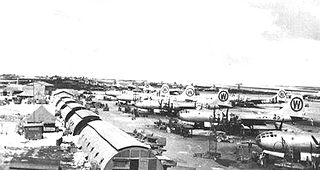
The 505th Bombardment Group is an inactive United States Air Force unit. Its last assignment was with Thirteenth Air Force, stationed at Clark Field, Philippines. It was inactivated on 30 June 1946.
Grey Goose Island is one of several, larger, uninhabited Canadian arctic islands in Nunavut, Canada located within the midsection of James Bay. Other comparable islands in the area include the Bear Islands, North and South Twin Islands, Spencer Island, Sunday Island, and Walter Island. La Grande River and the Cree village of Chisasibi, Quebec are 65 km (40 mi) to the southeast.

The Bombing of Singapore (1944–1945) was a military campaign conducted by the Allied air forces during World War II. United States Army Air Forces (USAAF) long-range bomber units conducted 11 air raids on Japanese-occupied Singapore between November 1944 and March 1945. Most of these raids targeted the island's naval base and dockyard facilities, and minelaying missions were conducted in nearby waters. After the American bombers were redeployed, the British Royal Air Force assumed responsibility for minelaying operations near Singapore and these continued until 24 May 1945.
Tisbury Great Island Bomb Area was a former naval bomb area for aviators, located in Great Pond, in Tisbury, Massachusetts.
Gull Island Bomb Area was a former naval bomb area for aviators, located on Gull Island, in Gosnold, Massachusetts.

Gull Island is a small island located just off the southeast coast of Penikese Island. It is part of the Elizabeth Islands and is entirely part of the town of Gosnold in Dukes County, Massachusetts. It was at one point used as a naval bomb area for aviators. Currently, it is uninhabited.
